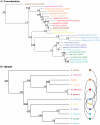Inferring species trees from gene trees in a radiation of California trapdoor spiders (Araneae, Antrodiaetidae, Aliatypus)
- PMID: 21966507
- PMCID: PMC3180454
- DOI: 10.1371/journal.pone.0025355
Inferring species trees from gene trees in a radiation of California trapdoor spiders (Araneae, Antrodiaetidae, Aliatypus)
Abstract
Background: The California Floristic Province is a biodiversity hotspot, reflecting a complex geologic history, strong selective gradients, and a heterogeneous landscape. These factors have led to high endemic diversity across many lifeforms within this region, including the richest diversity of mygalomorph spiders (tarantulas, trapdoor spiders, and kin) in North America. The trapdoor spider genus Aliatypus encompasses twelve described species, eleven of which are endemic to California. Several Aliatypus species show disjunct distributional patterns in California (some are found on both sides of the vast Central Valley), and the genus as a whole occupies an impressive variety of habitats.
Methodology/principal findings: We collected specimens from 89 populations representing all described species. DNA sequence data were collected from seven gene regions, including two newly developed for spider systematics. Bayesian inference (in individual gene tree and species tree approaches) recovered a general "3 clade" structure for the genus (A. gulosus, californicus group, erebus group), with three other phylogenetically isolated species differing slightly in position across different phylogenetic analyses. Because of extremely high intraspecific divergences in mitochondrial COI sequences, the relatively slowly evolving 28S rRNA gene was found to be more useful than mitochondrial data for identification of morphologically indistinguishable immatures. For multiple species spanning the Central Valley, explicit hypothesis testing suggests a lack of monophyly for regional populations (e.g., western Coast Range populations). Phylogenetic evidence clearly shows that syntopy is restricted to distant phylogenetic relatives, consistent with ecological niche conservatism.
Conclusions/significance: This study provides fundamental insight into a radiation of trapdoor spiders found in the biodiversity hotspot of California. Species relationships are clarified and undescribed lineages are discovered, with more geographic sampling likely to lead to additional species diversity. These dispersal-limited taxa provide novel insight into the biogeography and Earth history processes of California.
Conflict of interest statement
Figures





Similar articles
-
Cryptic elevational zonation in trapdoor spiders (Araneae, Antrodiaetidae, Aliatypus janus complex) from the California southern Sierra Nevada.Mol Phylogenet Evol. 2018 Jan;118:403-413. doi: 10.1016/j.ympev.2017.09.003. Epub 2017 Sep 15. Mol Phylogenet Evol. 2018. PMID: 28919504
-
Multilocus genealogies reveal multiple cryptic species and biogeographical complexity in the California turret spider Antrodiaetus riversi (Mygalomorphae, Antrodiaetidae).Mol Ecol. 2007 Feb;16(3):583-604. doi: 10.1111/j.1365-294X.2006.03164.x. Mol Ecol. 2007. PMID: 17257115
-
A total evidence assessment of the phylogeny of North American euctenizine trapdoor spiders (Araneae, Mygalomorphae, Cyrtaucheniidae) using Bayesian inference.Mol Phylogenet Evol. 2006 Oct;41(1):70-85. doi: 10.1016/j.ympev.2006.04.026. Epub 2006 May 12. Mol Phylogenet Evol. 2006. PMID: 16857391
-
Trapped indoors? Long-distance dispersal in mygalomorph spiders and its effect on species ranges.J Comp Physiol A Neuroethol Sens Neural Behav Physiol. 2021 Mar;207(2):279-292. doi: 10.1007/s00359-020-01459-x. Epub 2021 Jan 30. J Comp Physiol A Neuroethol Sens Neural Behav Physiol. 2021. PMID: 33515318 Review.
-
Advances in the reconstruction of the spider tree of life: A roadmap for spider systematics and comparative studies.Cladistics. 2023 Dec;39(6):479-532. doi: 10.1111/cla.12557. Epub 2023 Oct 3. Cladistics. 2023. PMID: 37787157 Review.
Cited by
-
Phylogenomic analysis and revised classification of atypoid mygalomorph spiders (Araneae, Mygalomorphae), with notes on arachnid ultraconserved element loci.PeerJ. 2019 May 3;7:e6864. doi: 10.7717/peerj.6864. eCollection 2019. PeerJ. 2019. PMID: 31110925 Free PMC article.
-
Three new species in the harvestmen genus Acuclavella (Opiliones, Dyspnoi, Ischyropsalidoidea), including description of male Acuclavella quattuor Shear, 1986.Zookeys. 2013 Jun 20;(311):19-68. doi: 10.3897/zookeys.311.2920. Print 2013. Zookeys. 2013. PMID: 23825441 Free PMC article.
-
Microgeographic population structuring in a genus of California trapdoor spiders and discovery of an enigmatic new species (Euctenizidae: Promyrmekiaphila korematsui sp. nov.).Ecol Evol. 2024 Mar 1;14(3):e10983. doi: 10.1002/ece3.10983. eCollection 2024 Mar. Ecol Evol. 2024. PMID: 38435003 Free PMC article.
-
Discovery of a glowing millipede in California and the gradual evolution of bioluminescence in Diplopoda.Proc Natl Acad Sci U S A. 2015 May 19;112(20):6419-24. doi: 10.1073/pnas.1500014112. Epub 2015 May 4. Proc Natl Acad Sci U S A. 2015. PMID: 25941389 Free PMC article.
-
Phylogeography and cohesion species delimitation of California endemic trapdoor spiders within the Aptostichus icenoglei sibling species complex (Araneae: Mygalomorphae: Euctenizidae).Ecol Evol. 2023 Apr 26;13(4):e10025. doi: 10.1002/ece3.10025. eCollection 2023 Apr. Ecol Evol. 2023. PMID: 37122769 Free PMC article.
References
-
- Myers N, Mittermeier RA, Mittermeier CG, da Fonseca GAB, Kent J. Biodiversity hotspots for conservation priorities. Nature. 2000;403:853–858. - PubMed
-
- Wakabayashi J, Sawyer TL. Stream incision, tectonics, uplift, and evolution of topography of the Sierra Nevada, California. Journal of Geology. 2001;109:539–562.
-
- Jockusch EL, Wake DB. Falling apart and merging: diversification of slender salamanders (Plethodontidae: Batrachoseps) in the American West. Biological Journal of the Linnean Society. 2002;76:361–391.
-
- Feldman CR, Spicer GS. Comparative phylogeography of woodland reptiles in California: repeated patterns of cladogenesis and population expansion. Molecular Ecology. 2006;15:2201–2222. - PubMed
-
- Starrett J, Hedin M. Multilocus genealogies reveal multiple cryptic species and biogeographical complexity in the California turret spider Antrodiaetus riversi (Mygalomorphae, Antrodiaetidae). Molecular Ecology. 2007;16:583–604. - PubMed
Publication types
MeSH terms
Substances
LinkOut - more resources
Full Text Sources
Molecular Biology Databases

